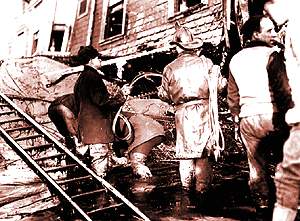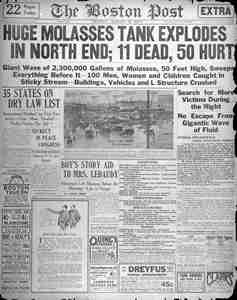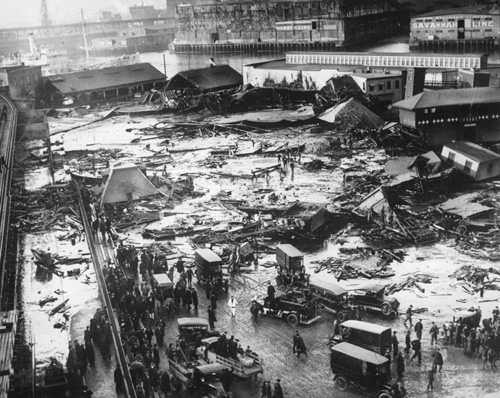Molasses and rum
Molasses: the lazy way to make your own fuel.
You can make 180 proof ethanol fuel for only $1.00/gallon, or less.



The Great Molasses Tragedy!
Now for a sobering piece of history about molasses: this is from: http://home.nycap.rr.com/useless/molasses/molasses.html


This is a story that I had heard when I was very
young, but cannot place its origins. It was one of those stories that I always assumed was pure fiction until I stumbled upon it once again more than twenty years later.
young, but cannot place its origins. It was one of those stories that I always assumed was pure fiction until I stumbled upon it once again more than twenty years later.
Clearly (since you can read the title above), I am talking about the Great Molasses Flood that swept through part of Boston, Massachusetts on January 15, 1919.
At this time in history, molasses was America's primary sweetener. It was used to make all types of cookies, cakes, bread, and especially rum.
Due to its popularity at the time, there were many molasses factories, warehouses, and storage tanks lining the shores of Boston. After all, Boston was considered to be the distilling capital of the United States.
To tell this story, we are only concerned with one of these facilities - a large storage tank located in Boston's north end - near the sites where the world famous Fanuel Hall (Quincy Market) and the New England Aquarium stand today.
This was no small tank of molasses. The tank stood over 50 feet tall. Estimates of its capacity range from 2.2 to 2.5 million gallons!
And we all know where this story is going. A sudden thunderous cracking sound was heard. The tank exploded and all the molasses began to flow down the city streets.
The actual wall of molasses was estimated to be from 15 - 30 feet high and moved at 25-35 miles per hour in the area around the tank. The depth was only (only?!!) several feet in the surrounding area. You could not outrun this thing.
There was no chance of saving anyone in its destructive path. Anyone that attempted to go near the sticky goo got stuck in it themselves and could have been cooked alive. It could suck your boots right off your feet.
attempted to go near the sticky goo got stuck in it themselves and could have been cooked alive. It could suck your boots right off your feet.
The actual wall of molasses was estimated to be from 15 - 30 feet high and moved at 25-35 miles per hour in the area around the tank. The depth was only (only?!!) several feet in the surrounding area. You could not outrun this thing.
There was no chance of saving anyone in its destructive path. Anyone that
 attempted to go near the sticky goo got stuck in it themselves and could have been cooked alive. It could suck your boots right off your feet.
attempted to go near the sticky goo got stuck in it themselves and could have been cooked alive. It could suck your boots right off your feet. The flood killed twenty-one people and injured an additional 150. Some were suffocated, some cooked, and others were swept by the wave into the harbor. I guess you could say that these unfortunate people were molassessed to death. Not exactly how I wish to go. The wave also destroyed millions of dollars worth of property. Homes and warehouses were swept off their foundations and destroyed. Even part of the city's elevated train line was destroyed.
Once the flood stopped, cleanup began. They could not remove the trapped horses from the sticky mess, so they had to shoot them to death. Freshwater from the fire hydrants would not wash away the molasses, so salt water from the harbor had to be sprayed on the land.
It took over six months to remove the molasses from the cobblestone streets, theaters, businesses, automobiles, and homes. The Boston Harbor was also stained brown for six months (must have made for a beautiful photo opportunity).
Believe it or not, there were reports that the molasses would actually continue to creep out of the ground and cracks in the sidewalks for 30 years! Others claim that you can still smell traces of it on a very
hot day in the city.
So what happened to cause this mess? No one is really sure, but there are two theories: First, it was believed that the tank was overfilled due to the impended threat of prohibition. It cracked open due to the extra force.
An alternative explanation has to do with the weather that day. On the prior day, the temperature was only 2 degrees Fahrenheit above zero. On the day of the accident, it had quickly shot up to an unseasonably warm 40 degrees. Some believe that this caused rapid expansion of the molasses and overstressed the tank.
This accident is certainly one that will stick in the minds of Bostonians for many years to come.
The Smithsonian Magazine has an online article, http://www.mv.com/ipusers/arcade/molpark.htm









